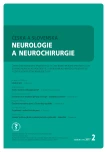Increased Muscle Tone in Pre-term Infants as a Sign of Neuromaturation and Options for its Assessment
Authors:
A. Můčková 1–3; M. Janura 1; J. Hálek 3
Authors‘ workplace:
Katedra přírodních věd v kinantropologii, FTK UP v Olomouci
1; Ústav fyzioterapie, FZV UP v Olomouci
2; Oddělení neonatologie, FN Olomouc
3
Published in:
Cesk Slov Neurol N 2017; 80/113(2): 146-149
Category:
Review Article
doi:
https://doi.org/10.14735/amcsnn2017146
Podpořeno grantem IGA FZV_2013_005.
Overview
Rising incidence of premature births increases the need for evaluation of neuromaturation and neurobehavioral development in pre-term infants. Fluctuating muscle tone in these children informs us of the neuromaturation of the central nervous system. Questions evaluating passive and active tone are included in many neurobehavioral scales and inform medical doctors and physiotherapists of the advancing developments of the lower motor centres. Achieving neonatal quality of limb flexion tone is the goal of neonatal physiotherapy, followed by paediatric physiotherapy that aims to involve higher motor centres.
Key words:
pre-term infant – neuromaturation – passive tone – active tone
The authors declare they have no potential conflicts of interest concerning drugs, products, or services used in the study.
The Editorial Board declares that the manuscript met the ICMJE “uniform requirements” for biomedical papers.
Sources
1. Vích M, Chmelíková B. Multioborová analýza současného stavu péče o předčasně narozené děti v ČR 2014. [assesed 21 Feb 2017]. Dostupné z URL: http:/ / docplayer.cz/ 1564118-Multioborova-analyza-soucasneho-stavu-pece-o-predcasne-narozene-deti-v-cr-praha-2014-koordinator-analyzy-ceske-zdravotnicke-forum-o-p-s.html.
2. Goldenberg RL, Culhane JF, Iams JD, et al. Epidemiology and causes of preterm birth. Lancet 2008;371(9606):75– 84. doi: 10.1016/ S0140-6736(08)60074-4.
3. Sharma PK, Sankar JM, Sapra S, et al. Growth and neurosensory outcomes of preterm very low birth weightinfants at 18 months of corrected age. Indian J Pediatr 2011;78(12):1485– 90. doi: 10.1007/ s12098-011-0442-9.
4. Botting N, Powls A, Cooke RW, et al. Cognitive and educational outcome of very-low-birthweight children in early adolescence. Dev Med Child Neurol 1998;40(10):652– 60. doi: 10.1111/ j.1469-8749.1998.tb12324.x.
5. Nikolic SJ, Ilic-Stosovic DD. Detection and prevalence of motor skill disorders. Res Dev Disabil 2009;30(6):1281– 7. doi: 10.1016/ j.ridd.2009.05.003.
6. Butler S, Als H. Individualized developmental care improves the lives of infants born preterm. Acta Pediatr 2008;97(9):1173– 5. doi: 10.1111/ j.1651-2227.2008.00916.x.
7. Allen MC, Aucott S, Cristofalo EA et al. Extrauterine neuromaturation of low risk preterm infants. Pediatr Res 2009;65(5):542– 7. doi: 10.1203/ PDR.0b013e3181998b86.
8. Duerden EG, Taylor MJ, Miller SP. Brain development in infants born preterm: looking beyond injury. Semin Pediatr Neurol 2013;20(2):65– 74. doi: 10.1016/ j.spen.2013.06.007.
9. Dylevský I. Dětský pohybový systém. Olomouc: Poznání 2012.
10. Gosselin J, Gahagan S, Amiel-Tison C. The Amiel-Tison neurological assessment at term: conceptual and methodological continuity in the course of follow-up. Ment Retard Dev Disabil Res Rev 2005;11(1):34– 51. doi: 10.1002/ mrdd20049.
11. Als H, Butler S, Kosta S, et al. The Assessment of Preterm Infants‘ Behavior (APIB): furthering the understanding and measurement of neurodevelopmental competence in preterm and full-term infants. Ment Retard Dev Disabil Res Rev 2005;11(1):94– 102. doi: 10.1002/ mrdd.20053.
12. Vojta V, Peters A. Vojtův princip. Praha: Grada Publishing 2010.
13. Vlach V. Novorozenec. In: Lesný I, ed. Obecná vývojová neurologie. Praha: Avicenum 1987.
14. Dubowitz L, Dubowitz V, Mercuri E. The neurological assessment of the preterm a full-term newborn infant. 2nd ed. London: Mac Keith Press 1999.
15. Ballard J, Khoury C, Wedig K, et al. New Ballard Score, expanded to include extremely premature infants. J Pediatr 1991;119(3):417– 23.
16. Korner A, Brown J, Thom V, et al. The neurobehavioral assessment of the preterm infant. USA: San Antonio: Child Development Media 2000.
17. Morgan AM, Koch V, Lee V, et al. Neonatal neurobehavioral examination a new instrument for quantitative analysis of neonatal neurological status. Phys Ther 1988;68(9):1352– 8.
18. André-Thomas, Chesni Y, Saint-Anne D. The neurological examination of the infant. Little Club Clinics in Developmental Medicine. London: Heinemann 1960.
19. Allen MC, Capute AJ. Tone and reflex development before term. Pediatrics 1990;85:393– 9.
20. Mercuri E, Guzzetta A, Laroche S, et al. Neurologic examination of preterm infants at term age: comparison with term infants. J Pediatr 2003;142(6):647– 55.
21. Ricci D, Romeo DM, Haataja L, et al. Neurological examination of preterm infants at term equivalent age. Early Hum Dev 2008;84(11):751– 61. doi: 10.1016/ j.earlhumdev.2008.05.007.
Labels
Paediatric neurology Neurosurgery NeurologyArticle was published in
Czech and Slovak Neurology and Neurosurgery

2017 Issue 2
- Metamizole vs. Tramadol in Postoperative Analgesia
- Metamizole at a Glance and in Practice – Effective Non-Opioid Analgesic for All Ages
- Memantine in Dementia Therapy – Current Findings and Possible Future Applications
- Memantine Eases Daily Life for Patients and Caregivers
- Advances in the Treatment of Myasthenia Gravis on the Horizon
Most read in this issue
- Ulnar Nerve
- Stroke Incidence in Europe – a Systematic Review
- Anti-NMDAR Encephalitis in Children – a Case Report
- Febrile Seizures – Guidelines for Examination of a Child with Simple Febrile Seizures, Adapted from the Guidelines of the American Academy of Pediatrics
